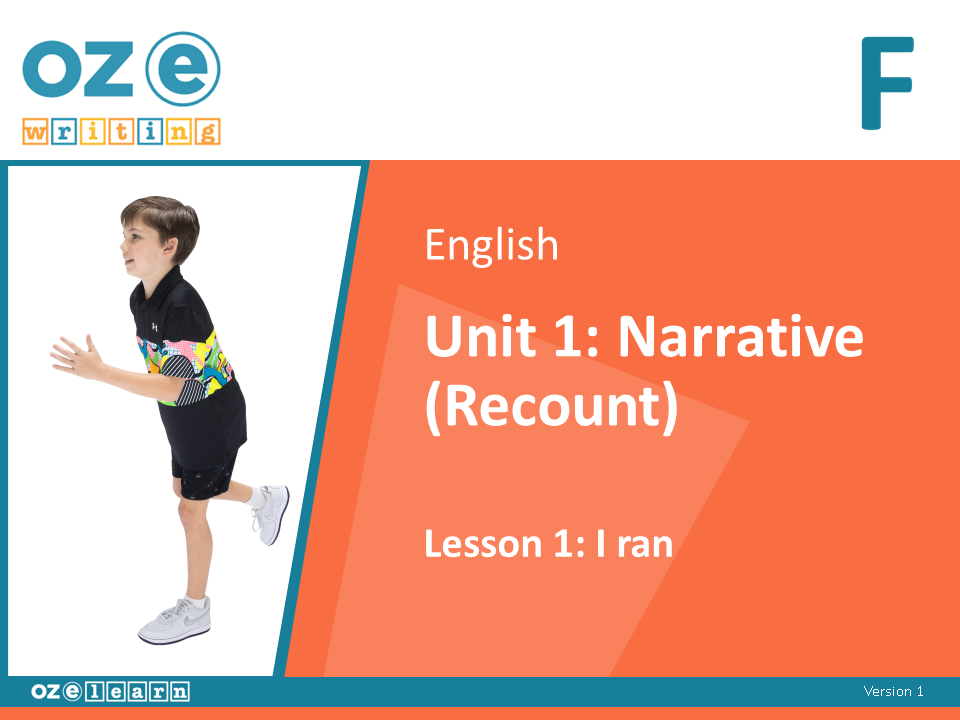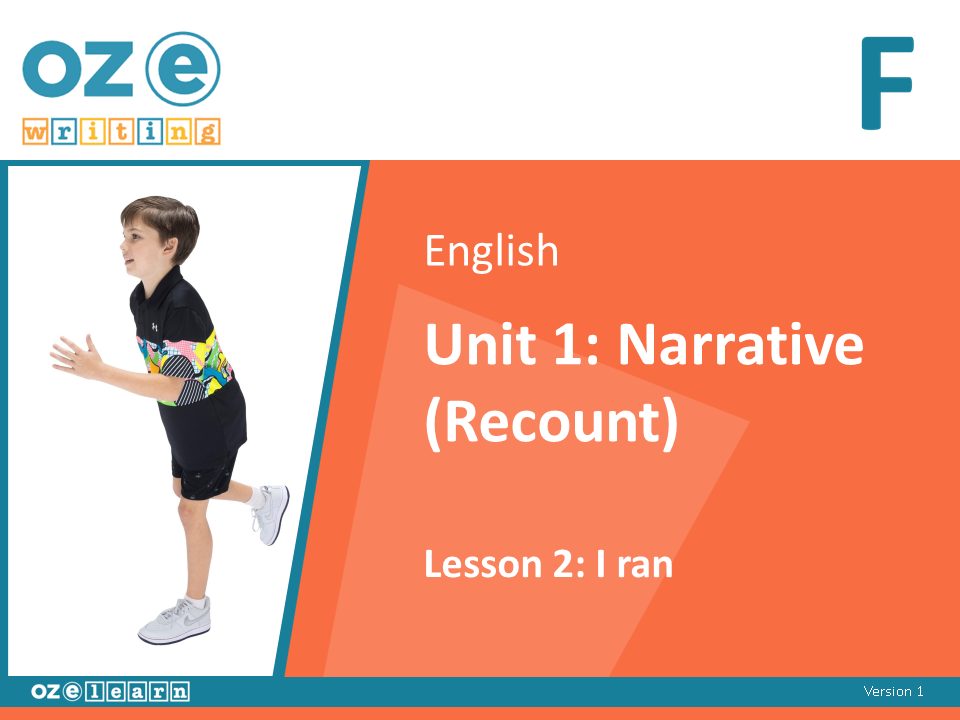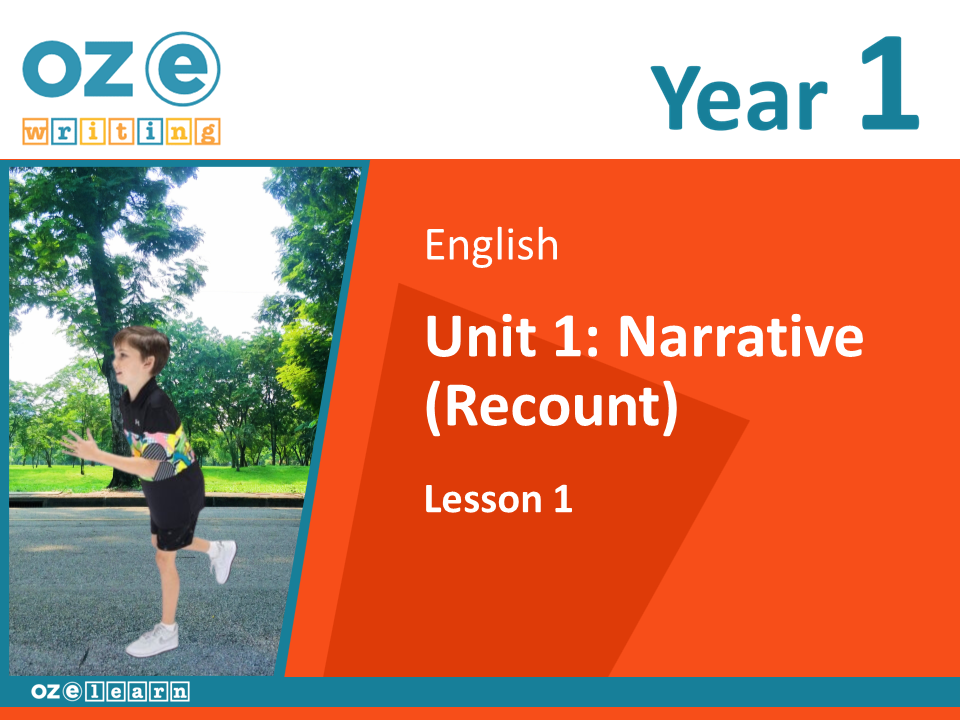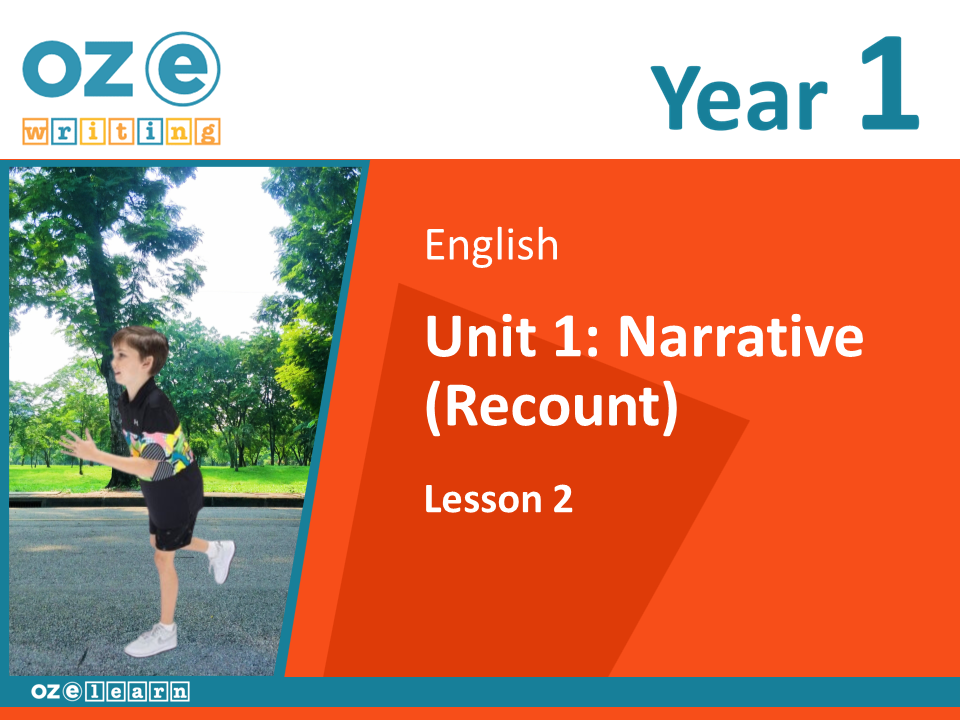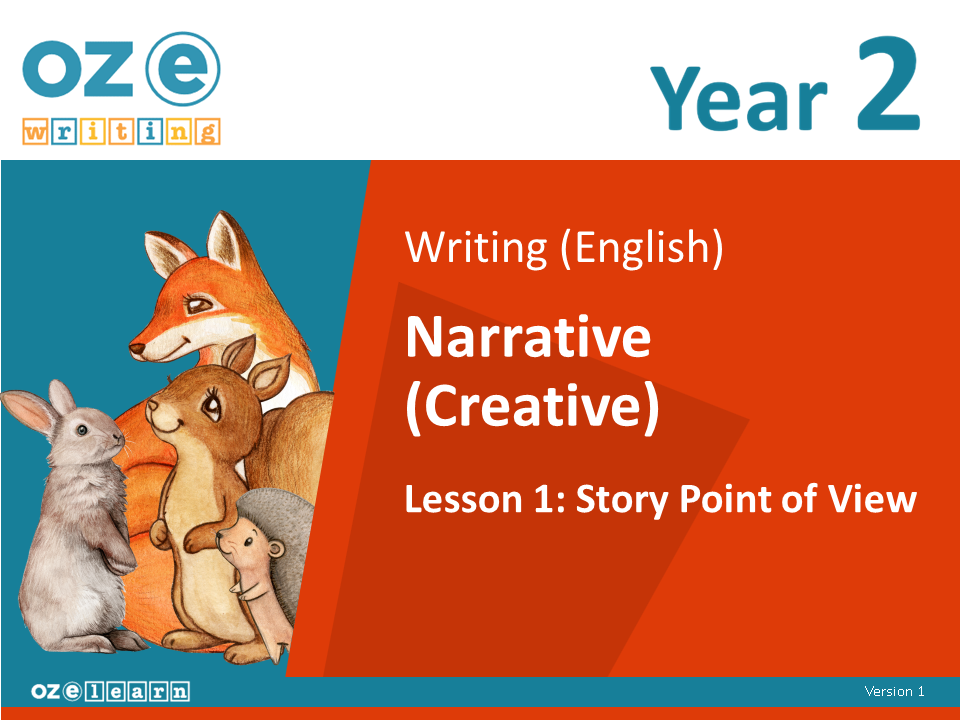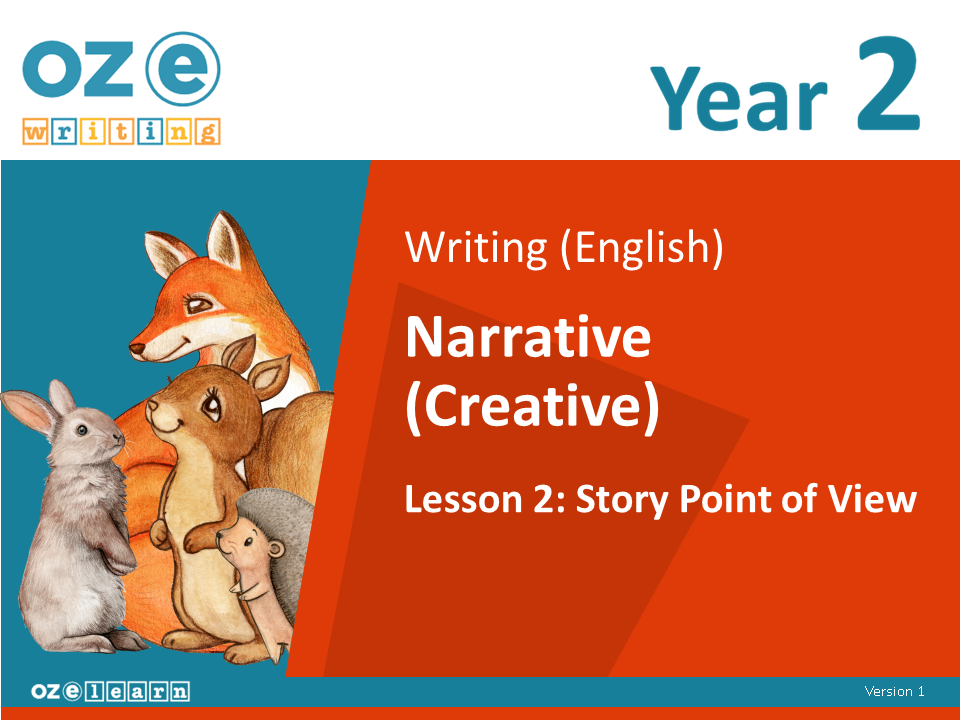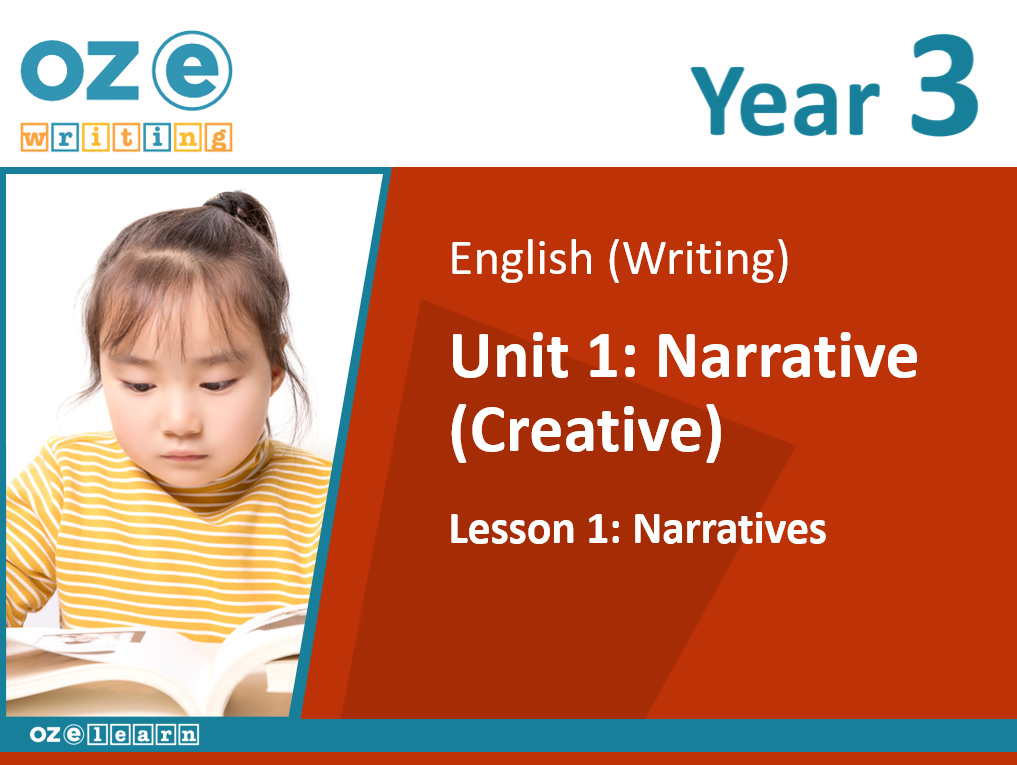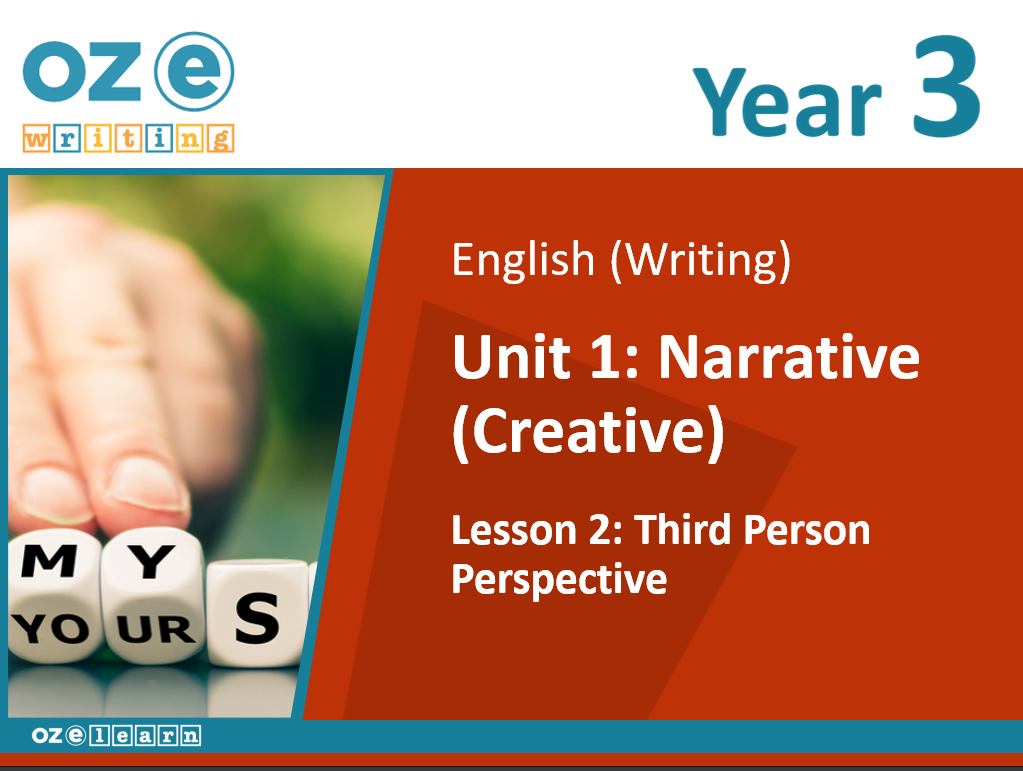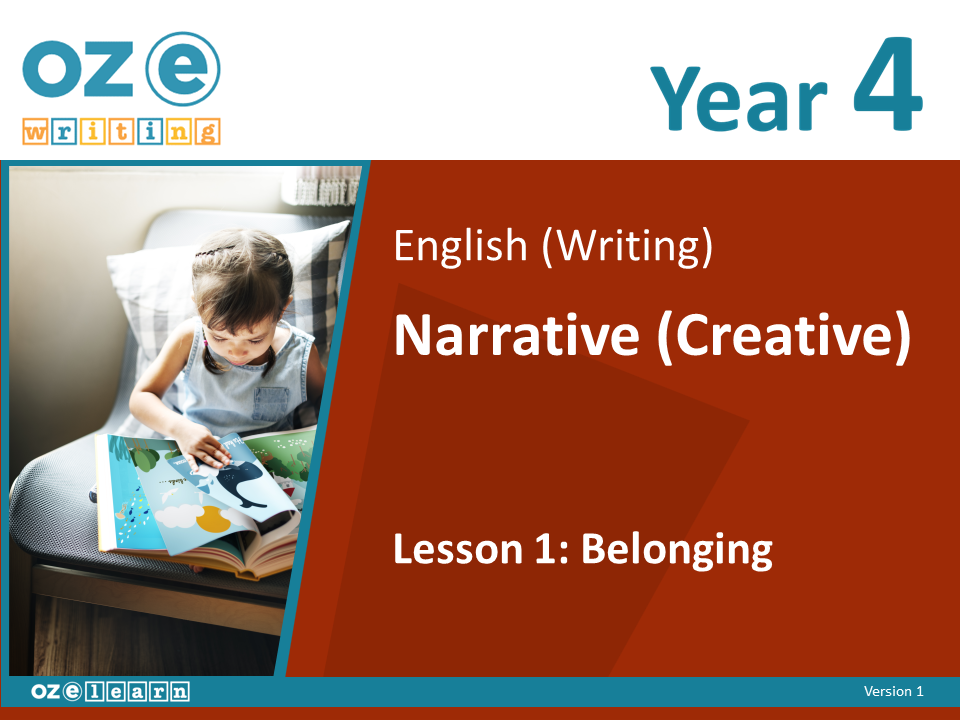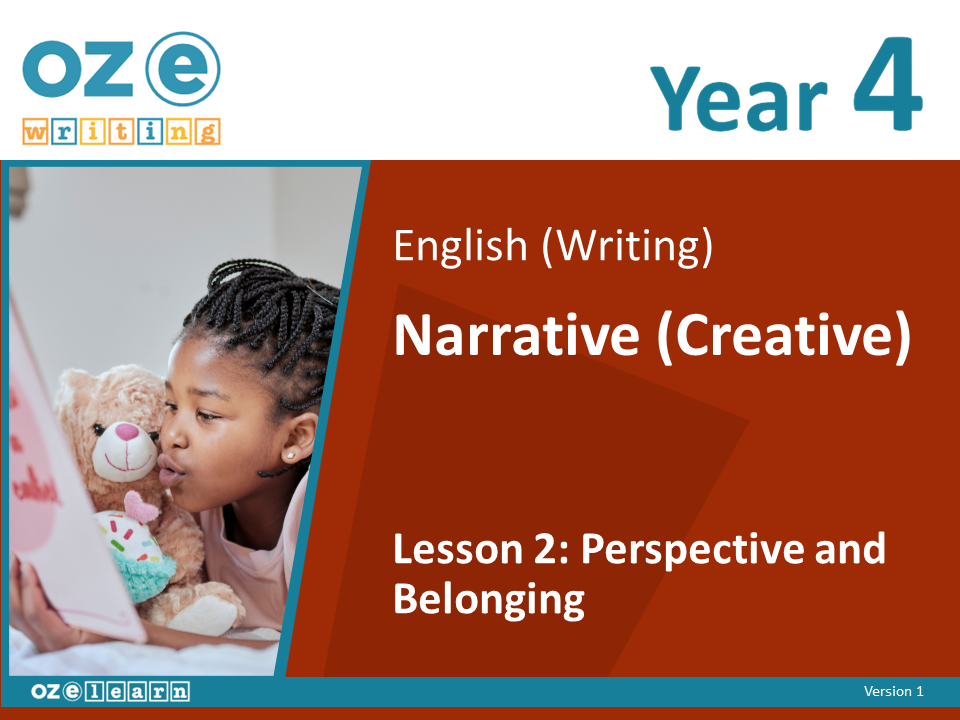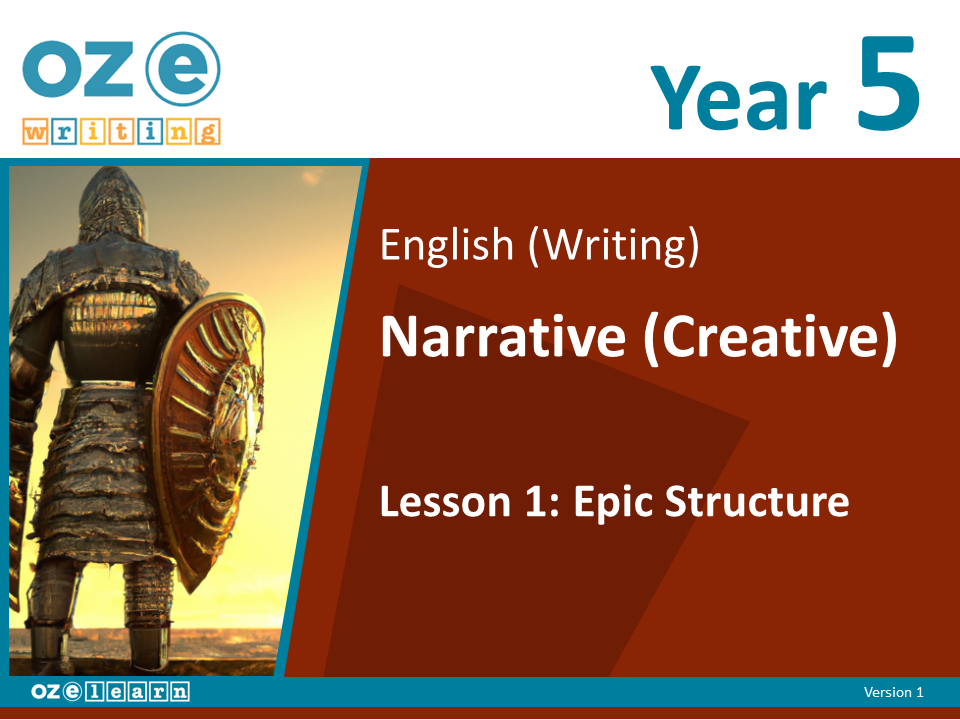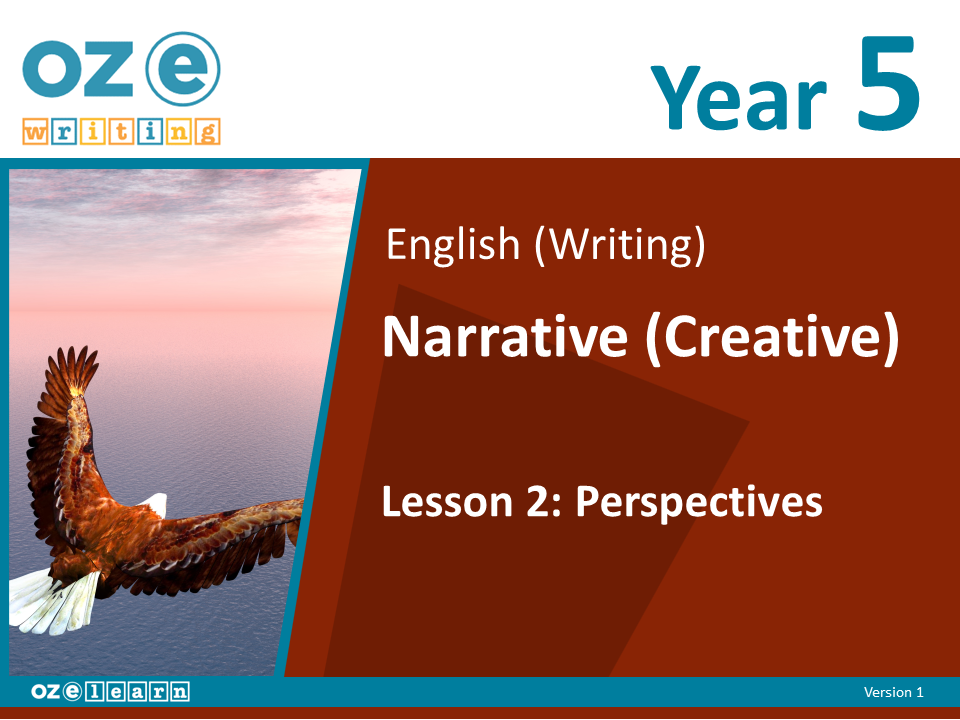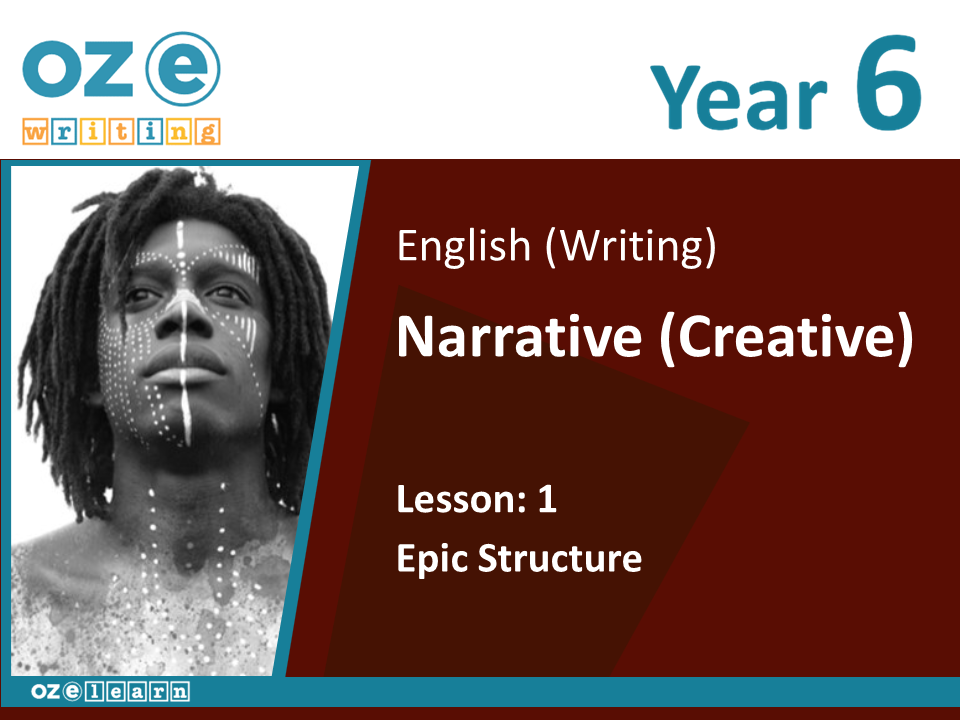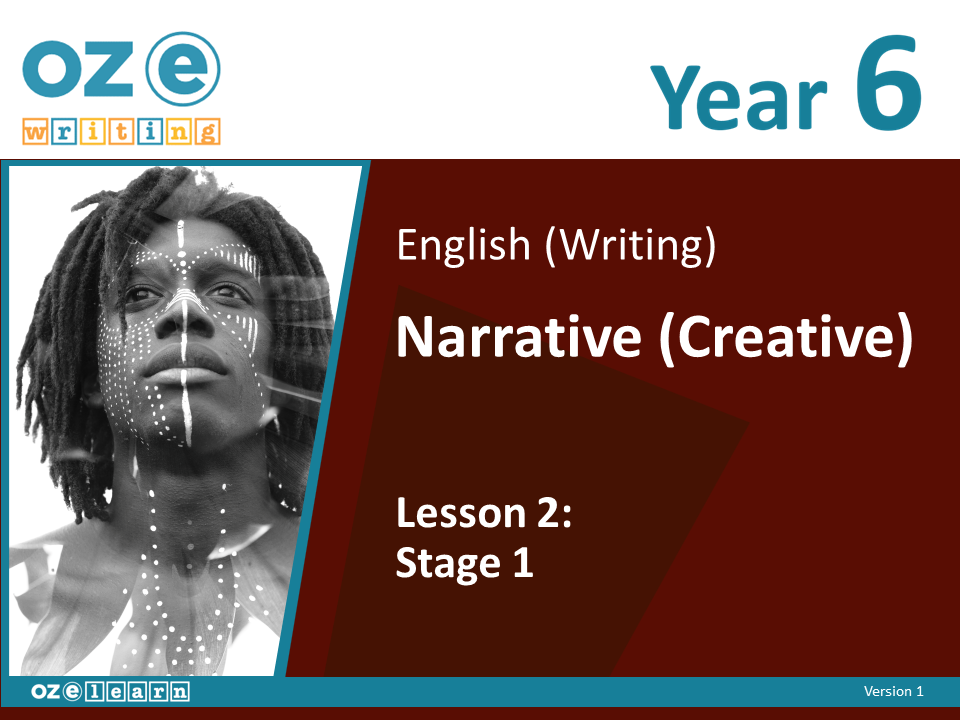Oz-e-writing Years F-6
Unit 1
Oz-e-writing F-6 is a writing program that has an explicit instruction pedagogy, focuses on Australian perspectives, and covers the Australian Curriculum requirements for language and literacy.
Free Starter Lessons
Unit Overviews
Australian Curriculum Content Descriptions
Unit 1 Narrative (Recount) is a writing program for Foundation Year students. It aligns to the Australian Curriculum V9.0.:
- AC9EFLA04 – Understand conventions of print and screen, including how books and simple digital texts are usually organised.
- Learning that Standard Australian English in written texts is read from left to right usually from top to bottom of the page.
- Discussing the placement of images and words in text.
- AC9EFLA05 – Recognise that sentences are key units for expressing ideas.
- Learning that word order in sentences is important for meaning; for example, ‘The boy sat on the dog.’ ‘The dog sat on the boy.’
- AC9EFLA06 – Recognise that sentences are made up of groups of words that work together in particular ways to make meaning.
- Learning how words in a sentence relate to one another, for example, connecting a cat (noun) to ate (verb), or black (adjective) to a cat (noun).
- AC9EFLA07 – Explore the contribution of images and words to meaning in stories and informative texts.
- Recognising that texts can be interpreted differently when only the words or only the images are read or viewed.
- AC9EFLA08 – Recognise and develop awareness of vocabulary used in familiar contexts related to everyday experiences, personal interests and topics taught at school.
- Identifying words for a topic studied at school; for example, words relevant to home.
- AC9EFLA09 – Identify punctuation as a feature of written text different from letters; recognise that capital letters are used for names, and that capital letters also signal the beginning of sentences while punctuation marks signal the end.
- Commenting on capital letters encountered in everyday texts; for example, ‘That’s the letter that starts my name.’ ‘The name of my family and my town have capital letters.’
- AC9EFLE02 – Respond to stories and share feelings and thoughts about their events and characters/
- Using drawing and beginning forms of writing to express personal responses to stories, poems or films.
- Discussing events and characters in texts and connecting them to their own experiences.
- AC9EFLY08 – Form most lower and upper-case letters using learnt letter formations.
- Follow clear demonstrations of how to construct each letter, for example, where to start and in which direction to write.
- Developing a functional pencil grip grasp.
Learning Objectives
In lessons 1 to 45, students learn:
- Standard Australian English is written from left to right.
- Word order in sentences is important for meaning.
- Relationship between words in a sentence. Syntax. Grammar.
- Recognise the importance of images in relaying meaning.
- Identify and read words used to describe everyday personal experiences.
- Recognise the role of capital letters and the function of basic punctuation.
- Use drawing and beginning forms of writing to express ideas.
- Discuss and compare sentences connected to their personal experiences.
Success Criteria
- Students say and read recounted events. Students draw a recounted event.
- Students say and read recounted events. Students cut and paste and create a recount sentence.
- Students say and read recounted events. Students trace a recount sentence with correct punctuation, letter formation, left to right sweep and functioning pencil grip.
- Students make up and jointly write recount sentences based on exemplar sentence.
- Students say, compose and independently write recount sentences based on exemplar sentence.
Assessment
At Foundation level, descriptive wording about students’ progress over the unit is used rather than an A–E achievement scale. The Assessment Rubric is referenced to the Foundation level achievement standard in the Australian Curriculum Version 9.0. It incorporates content descriptions and elaborations. Based on evidence, teachers make an on-balance judgement to decide which standard of performance the student is achieving. Using the Progress Tests and End-of-Unit Assessment, teachers moderate work and modify the rubric. This will provide qualitive and diagnostic feedback on student learning within the unit.
A progress test will be completed during week 3 and 6.
Each progress test will include assessment tasks that will assess the content taught during prior weeks.
End-of-Unit Assessment is to be conducted at the completion of all lessons.
APPLE questions and Check for Understanding slides provide teachers with the opportunity to assess student understanding at the time of instruction and to drive classroom discussions.
Australian Curriculum Content Descriptions
Oz-e-writing Year 1 Narrative (Recount) Unit 1 is a writing unit for Year 1 students. It aligns to the Australian Curriculum V9.0.:
- AC9E1LA03 – Explore how texts are organised according to their purpose, such as to recount, narrate, express opinion, inform, report and explain.
- Discussing and comparing the purposes and organisation of familiar texts.
- AC9E1LA06 – Understand that a simple sentence consists of a single independent clause representing a single event or idea.
- Knowing that a single event or idea can include a process, a happening or a state (verb), the participant or who or what is involved (noun group/phrase), and the surrounding circumstances (adverb group/phrase).
- AC9E1LA07 – Understand that words can represent people, places and things (nouns, including pronouns), happenings and states (verbs), qualities (adjectives) and details such as when, where and how (adverbs)
- Understanding that words or groups of words can represent the participants (nouns; for example, people, places, things) that are involved in various activities or processes.
- AC9E1LA09 – Recognise the vocabulary of learning area topics.
- Identifying words for topics studied at school.
- AC9E1LA10 – Understand that written language uses punctuation such as full stops, question marks and exclamation marks, and uses capital letters for familiar proper nouns.
- Identifying different sentence boundary punctuation, when reading
- Identifying and using capital letters to name places and holidays.
- AC9E1LY02 – Use interaction skills including turn-taking, speaking clearly, using active listening behaviours and responding to the contributions of others, and contributing ideas and questions.
- Participating in informal and structured class, group and pair discussions about content area topics, ideas and information.
- AC9E1LY06 – Create and re-read to edit short written and/or multimodal texts to report on a topic, express an opinion or recount a real or imagined event, using grammatically correct simple sentences, some topic-specific vocabulary, sentence boundary punctuation and correct spelling of some one- and two-syllable words.
- Applying emerging knowledge of text structure and grammar when creating text.
- Using learning area vocabulary when creating text.
- AC9E1LY08 – Write words using unjoined lower-case and upper-case letters.
- Continuing to develop a functional pencil grip/grasp.
Learning Objectives
In lessons 1 to 45, students learn:
- Word order in sentences is important for meaning.
- Relationship between words in a sentence. Syntax.
- Verbs in the past tense for recount speaking, reading and writing.
- Grammatical terminology and function: verb, noun and pronoun.
- Read extended recount sentences with phrases of time and attribute.
- Recognise the importance of images in relaying meaning.
- Identify and read words used to describe everyday personal experiences.
- Recognise the role of capital letters and the function of basic punctuation. Apply to own writing.
- Use drawing and writing to express ideas.
- Discuss and compare sentences connected to their personal experiences.
Success Criteria
- Students say and read recounted events. Students draw a recounted event.
- Students say and read recounted events. Students cut and paste and create a recount sentence.
- Students say and read recounted events. Students trace a recount sentence with correct punctuation, letter formation, left to right sweep and functioning pencil grip.
- Students learn grammatical names meaning and function of nouns, verbs and pronouns within a sentence.
- Students make up and jointly write recount sentences based on exemplar sentence.
- Students engage in discussion of personal past events and use verbs in the past tense.
- Students say, compose and independently write recount sentences based on exemplar sentence.
Assessment
At Year 1 level, students’ progress over the unit can be marked using an A–E achievement scale. The Assessment Rubric is referenced to the Year 1 level achievement standard in the Australian Curriculum 9.0. It incorporates content descriptions and elaborations. Based on evidence teachers make an on-balance judgement to decide which standard of performance the student is achieving. Using the Progress Tests and End of Unit Assessment teachers moderate work and modify the rubric. This will provide qualitive and diagnostic feedback on student learning within the Unit.
A progress test will be completed during week 3 and 6 of the unit. Each progress test will include assessment tasks that will assess the content taught during prior weeks. A mark out of 20 will be awarded to each Progress Test.
End of Unit Assessment is to be conducted at the completion of all lessons. A mark out of 60 will be awarded.
APPLE questions and Check for Understanding slides provide teachers with the opportunity to assess student understanding at the time of instruction and to drive classroom discussions.
Australian Curriculum Content Descriptions
Unit 1 Narrative (Recount) is a writing unit for Year 2 students. It aligns to the Australian Curriculum V9.0.:
- AC9E2LA03 – Identify how texts across the curriculum are organised differently and use language features depending on purposes.
- AC9E2LA04 – Understand how texts are made cohesive by using personal and possessive pronouns and by omitting words that can be inferred.
- AC9E2LA06 – Understand that connections can be made between ideas by using a compound sentence with 2 or more independent clauses usually linked by a coordinating conjunction.
- AC9E2LA07 – Understand that in sentences nouns may be extended into noun groups using articles and adjectives, and verbs may be expressed as verb groups.
- AC9E2LA08 – Understand that images add to or multiply the meanings of a text.
- AC9E2LA10 – Recognise that capital letters are used in titles and commas are used to separate items in lists.
- AC9E2LE01 – Discuss how characters and settings are connected in literature created by First Nations Australian, and wide-ranging Australian and world authors and illustrators.
- AC9E2LE02 – Identify features of literary texts, such as characters and settings, and give reasons for personal preferences.
- AC9E2LE03 – Discuss the characters and settings of a range of texts and identify how language is used to present these features in different ways.
- AC9E2LE05 – Create and edit literary texts by adapting structures and language features of familiar literary texts through drawing, writing, performance and digital tools.
- AC9E2LY02 – Use interaction skills when engaging with topics, actively listening to others, receiving instructions and extending own ideas, speaking appropriately, expressing and responding to opinions, making statements, and giving instructions.
- AC9E2LY05 – Use comprehension strategies such as visualising, predicting, connecting, summarising, monitoring and questioning to build literal and inferred meaning.
- AC9E2LY06 – Create and edit short imaginative, informative and persuasive written and/or multimodal texts for familiar audiences, using text structure appropriate to purpose, simple and compound sentences, noun groups and verb groups, topic-specific vocabulary, simple punctuation and common 2-syllable words.
- AC9E2LY07 – Create, rehearse and deliver short oral and/or multimodal presentations for familiar audiences and purposes, using text structure appropriate to purpose and topic-specific vocabulary, and varying tone, volume and pace.
Learning Objectives
In lessons 1 to 45, students learn:
- Word order in sentences is important for meaning.
- Relationship between words in a sentence. Syntax.
- Verbs in the past tense for recount speaking, reading and writing.
- Grammatical terminology and function: verb, noun and pronoun.
- Read extended recount sentences with phrases of time and attribute.
- Recognise the importance of images in relaying meaning.
- Identify and read words used to describe everyday personal experiences.
- Recognise the role of capital letters and the function of basic punctuation. Apply to own writing.
- Use drawing and writing to express ideas.
- Discuss and compare sentences connected to their personal experiences.
Success Criteria
- Students say and read recounted events. Students draw a recounted event.
- Students say and read recounted events. Students cut and paste and create a recount sentence.
- Students say and read recounted events. Students trace a recount sentence with correct punctuation, letter formation, left to right sweep and functioning pencil grip.
- Students learn grammatical names meaning and function of nouns, verbs and pronouns within a sentence.
- Students make up and jointly write recount sentences based on exemplar sentence.
- Students engage in discussion of personal past events and use verbs in the past tense.
- Students say, compose and independently write recount sentences based on exemplar sentence.
- Students demonstrate understand and apply simple punctuation: capital letters and full stops.
Assessment
At Year 1 level, students’ progress over the unit can be marked using an A–E achievement scale. The Assessment Rubric is referenced to the Year 1 level achievement standard in the Australian Curriculum 9.0. It incorporates content descriptions and elaborations. Based on evidence teachers make an on-balance judgement to decide which standard of performance the student is achieving. Using the Progress Tests and End of Unit Assessment teachers moderate work and modify the rubric. This will provide qualitive and diagnostic feedback on student learning within the Unit.
A Progress Test will be completed during week 3 and 6 of the unit. Each progress test will include assessment tasks that will assess the content taught during prior weeks. A mark out of 20 will be awarded to each Progress Test.
End of Unit Assessment is to be conducted at the completion of all lessons. A mark out of 60 will be awarded.
APPLE questions and Check for Understanding slides provide teachers with the opportunity to assess student understanding at the time of instruction and to drive classroom discussions.
Australian Curriculum Content Descriptions
Overview
Text Structure and Organisation
- Understand how different types of texts vary in their use of language choices depending on their purpose and context (for example, tense and types of sentences) (ACELA1478).
- Know that word contractions are a feature of informal language and that apostrophes of contraction are used to signal missing letters (ACELA1480).
Expressing and Developing Ideas
- Understand that a clause is a unit of grammar usually containing a subject and a verb and that these need to be in agreement (ACELA1481).
- Understand that verbs represent different processes, for example, doing, thinking, saying and relating, and that these processes are anchored in time through tense (ACELA1482).
- Learn extended and technical vocabulary and ways of expressing opinion, including modal verbs and adverbs (ACELA1484).
Note: Information on this page is subject to change as this program is currently being updated to align with version 9.0 of the Australian Curriculum. GGSA will release an updated version in early 2024.
Learning Objectives
In Lessons 1 to 10, students learn to:
- Write, edit and improve sentences about a character’s actions using regular past tense verbs.
- Write, edit and improve sentences with a subject verb agreement (has or have).
- Write, edit and improve compound sentences that replace the subject with a pronoun (third person – he and she).
- Write, edit and improve compound sentences that replace the subject with a pronoun (third person – it, they).
- Write, edit and improve compound sentences that use the possessive pronoun ‘its’.
- Write, edit and improve sentences that start with dialogue.
- Write, edit and improve sentences that end with dialogue.
- Write, edit and improve sentences with dialogue ending with a (questions).
- Write, edit and improve complex sentences (when).
- Write, edit and improve complex sentences (where).
Success Criteria
- Understand how language features are used to link and sequence ideas.
- Understand how language can be used to express feelings and opinions on topics.
- Include writing and images in texts to express and develop, in some detail, experiences, events, information, ideas and characters.
- Create a range of texts for familiar and unfamiliar audiences.
- Contribute actively to class and group discussions, asking questions, providing useful feedback and making presentations.
- Demonstrate understanding of grammar and choose vocabulary and punctuation appropriate to the purpose and context of their writing.
- Use knowledge of letter-sound relationships including consonant and vowel clusters and high-frequency words to spell words accurately.
- Re-read and edit their writing, checking their work for appropriate vocabulary, structure and meaning.
- Write using joined letters that are accurately formed and consistent in size.
Assessment
Progress Test
- Progress tests are conducted after Lesson 5. They allow teachers to monitor student understanding of the concepts taught over the past five lessons and identify where reteaching is needed.
- The Teaching Guide contains the progress test script and there is a handout for students to write their answers on.
End-of-Unit Assessment
- Week 10 is the end-of-unit assessment, which has the same variety of question formats as the progress tests (e.g. multiple choice, filling in blanks/punctuation, editing, constructing, and improving sentences) to assess student mastery of sentence level writing development from the unit.
- The Teaching Guide contains the testing questions and the end-of-unit assessment handout for students to write their answers on.
Australian Curriculum Content Descriptions
Oz-e-writing Year 4 Narrative (Creative) is a writing unit for Year 4 students. It aligns with the Australian Curriculum V9.0:
- Explore language used to develop relationships in formal and informal situations. AC9E4LA01
- Identify how texts across the curriculum have different language features and are typically organised into characteristic stages depending on purposes. (AC9E4LA03)
- Identify how text connectives including temporal and conditional words, and topic word associations are used to sequence and connect idea. (AC9E4LA04)
- Understand that complex sentences contain one independent clause and at least one dependent clause typically joined by a subordinating conjunction to create relationships, such as time and causality. (AC9E4LA06)
- Understand how adverb groups/phrases and prepositional phrases work in different ways to provide circumstantial details about an activity. (AC9E4LA08)
- Expand vocabulary by exploring a range of synonyms and antonyms. (AC9E4LA11)
- Describe the effects of text structures and language features in literary texts when responding to and sharing opinions. (AC9E4LE02)
- Discuss how authors and illustrators make stories engaging by the way they develop character, setting and plot tensions. (AC9E4LE03)
- Create and edit literary texts by developing storylines, characters and settings. (AC9E4LE05)
- Identify the characteristic features used in imaginative, informative and persuasive texts to meet the purpose of the text. (AC9E4LY03)
- Plan, create, edit and publish written and multimodal imaginative, informative and persuasive texts, using visual features, relevant linked ideas, complex sentences, appropriate tense, synonyms and antonyms, correct spelling of multisyllabic words and simple punctuation. (AC9E4LY06)
Learning Objectives
In lessons 1 to 45, students learn about:
- The narrative structure
- Themes
- How to plan and write a narrative
- Third Person Perspective
- Identifying, using, and creating different language features
- Editing
- Using rubrics for success.
Success Criteria
- Identify the structure of a narrative text.
- Identify and understand key vocabulary.
- Identify the main theme in an exemplar text.
- Joint construction of narrative components.
Assessment
Weeks 3 and 6
Each Progress Test is worth 20% (8% content, 12% writing)
A progress test will be completed during week 3 and 6 of the unit.
Each progress test will include two assessment tasks. One will assess the content taught during prior weeks and the other will assess writing.
Week 9
Final Assessment is worth 60% (60% writing)
One assessment task will be completed during week 9 of the unit.
The writing assessment will cover four components: Planning, writing, editing, and content (weeks 1-8).
APPLE questions provide teachers with the opportunity to assess student understanding and to drive classroom discussions.
Australian Curriculum Content Descriptions
Oz-e-writing Year 5 Narrative (Creative) is a writing unit for Year 5 students. It aligns to the Australian Curriculum V9.0.:
- Becoming familiar with the typical stages and language features of types of texts such as narrative, procedure, arguments, explanation, discussion and informative texts, and how they can be composed in written, digital and multimedia forms to achieve their purpose. (AC9E5LA03)
- Describing the stages and phases, and purposes of narratives, historical recounts, procedural recounts, causal explanations, discussions of alternative positions on an issue, information reports, reviews and types of poems. (AC9E5LA03)
- Observing how descriptive details can be built up around a noun or an adjective, forming a group (for example, “this very smelly cleaning cloth in the sink” is a noun group and “as pretty as the flowers in May” is an adjective group). (AC9E5LA06)
- Identifying language features such as use of dialogue and rich descriptive language, and presenting an opinion about their effect on readers. (AC9E5LE02)
- Discussing why an author might choose a particular point of view. (AC9E5LE03)
- Discussing how figurative language including simile and metaphor can make use of a comparison between different things. (AC9E5LE04)
- Drawing upon fictional elements in a range of model texts; for example, main idea, characterisation, setting (time and place) an devices; for example figurative language (simile, metaphor, personification) to experiment with new, creative ways of communicating ideas, experiences and stories in literary texts. (AC9E5LE05)
- Creating a visual map, which may include digital mind maps, of figurative language, storylines, characters and settings in a text that may inspire their own writing. (AC9E5LE05)
- Participating in pair, group, class, school and community speaking and listening situations including informal conversations, discussions, debates and presentations. (AC9E6LY02)
Learning Objectives
In Lessons 1 to 40, students learn about the purpose and universal structure of an epic.
- Stage 1 – The Hero.
- Stage 2 – Need.
- Stage 3 – Go.
- Stage 4 – Search.
- Stage 5 – Find.
- Stage 6 – Take.
- Stage 7 – Return.
- Stage 8 – Change.
Success Criteria
- Understand the purpose of an epic.
- Identify the stages of an epic.
- Understand different perspectives in writing.
- Write sentences from the first-person and third-person point of view.
- Brainstorm a Hero’s backstory.
- Write a paragraph about the Hero.
- Jointly plan the stages of an epic.
- Independently plan the stages of an epic.
- Develop your understanding of the settings in the first stage of an epic.
- Identify settings in an epic.
- Identify vocabulary and meaning of the text.
- Identify the elements of each stage of an epic.
- Build vocabulary about the setting, characters and events of an epic.
- Jointly write descriptive sentences about the setting, characters and events in a epic.
- Independently write descriptive sentences about the setting, characters and events in an epic.
- Jointly rewrite the exemplar text creating descriptive paragraphs about the setting, characters and events in an epic.
- Independently write the exemplar text creating descriptive paragraphs about the setting, characters and events in an epic.
- Add verbs to describe the Hero’s thoughts and emotions.
- Add similes to develop descriptions.
- Include metaphors to create vivid descriptions.
Assessment
Progress Tests
Progress Tests are conducted in weeks 3, and 6, allowing teachers to monitor student understanding and to identify where reteaching is needed.
The Teaching Guide contains the testing questions and answers, and the Student Assessment Booklet has a section where students write their answers. Marking guides are provided in the PowerPoints, Student Assessment Booklet and the Teaching Guide.
End-of-Unit Assessment
The end of unit assessment is an application of writing skills taught in the unit combined content covered throughout the unit.
APPLE questions throughout lessons provide teachers with the opportunity to assess student understanding and drive classroom discussions.
Australian Curriculum Content Descriptions
Oz-e-writing Year 6 Narrative (Creative) is a writing unit for Year 6 students. It aligns to the Australian Curriculum V9.0.:
- Identify authors’ use of vivid, emotive vocabulary, such as metaphors, similes, personification, idioms, imagery and hyperbole. (AC9E6LA08)
- Understand how ideas can be expanded and sharpened through careful choice of verbs, elaborated tenses and a range of adverb groups. (AC9E6LA06)
- Identify similarities and differences in literary texts on similar topics, themes or plots. (AC9E6LE02)
- Create and edit literary texts that adapt plot structure, characters, settings and/or ideas from texts students have experienced, and experiment with literary devices. (AC9E6LE05)
- Understand how embedded clauses can expand the variety of complex sentences to elaborate, extend and explain ideas. (AC9E6LA05)
- Understand how to use the comma for lists, to separate a dependent clause from an independent clause, and in dialogue. (AC9E6LA09)
- Analyse how text structures and language features work together to meet the purpose of a text, and engage and influence audiences. (AC9E6LY03)
- Plan, create, edit and publish written and multimodal texts whose purposes may be imaginative, informative and persuasive, using paragraphs, a variety of complex sentences, expanded verb groups, tense, topic-specific and vivid vocabulary, punctuation, spelling and visual features. (AC9E6LY06)
Learning Objectives
In Lessons 1 to 40, students learn about the purpose and universal structure of an epic.
- Stage 1 – The Hero.
- Stage 2 – Need.
- Stage 3 – Go.
- Stage 4 – Search.
- Stage 5 – Find.
- Stage 6 – Take.
- Stage 7 – Return.
- Stage 8 – Change.
Success Criteria
- Identify the stages of an epic.
- Compare and contrast two Heroes in the first stage of an epic
- Brainstorm the characteristics of an epic.
- Use character traits and create similes and metaphors to describe the Hero.
- Use figurative languages (simile, metaphor, personification, hyperbole, onomatopoeia and alliteration) and sensory details in writing an epic.
- Create the epic setting with figurative language.
- Compare and contrast stages of an epic.
- Use compound and complex sentences to plan the stages of an epic.
- Use one type of conflict to plan stages 4 and 5 of an epic.
- Use verb groups and modal verb groups to describe the thoughts, actions, dialogues or character traits of the epic character.
- Use sensory details to describe the Hero’s two worlds.
- Write sentences that build tension in an epic.
- Use tension different ways in writing stages 4 and 5.
- Use pacing words to help build tension in writing.
- Format dialogue correctly in writing.
- Write dialogues with different dialogue tags in writing.
- Identify character changes in reading.
- Show a character change using mental, action or speaking verbs.
- Identify adjectival phrases in reading.
- Write adjectives in the correct order in a sentence.
- Write sentences using comparative and superlative adjectives.
- Use adjectival phrase in writing an epic.
- Independently write and edit the different stages of an epic.
Assessment
Progress Tests
Progress Tests are conducted in weeks 3, 6 and 9, allowing teachers to monitor student understanding of the concepts taught and to identify where reteaching is needed.
The Teaching Guide contains the testing questions and answers, and the Student Assessment Workbook has a section where students write their answers. Marking guides are provided in the PowerPoints, the Teaching Guide and the Student Assessment Workbook.
End-of-Unit Assessment
The end of unit assessment is an application of writing skills taught in the unit combined with HASS content covered throughout the unit.
APPLE questions provide teachers with the opportunity to assess student understanding and drive classroom discussions.
Other Oz-e-writing Units
- Unit 2: Coming Soon!
- Unit 3: Coming Soon!
- Unit 4: Coming Soon!
Lesson Design
Lesson Objective
Success Criteria
Activating Prior Knowledge
I Do
We Do
Apple Question
You Do
Revise


